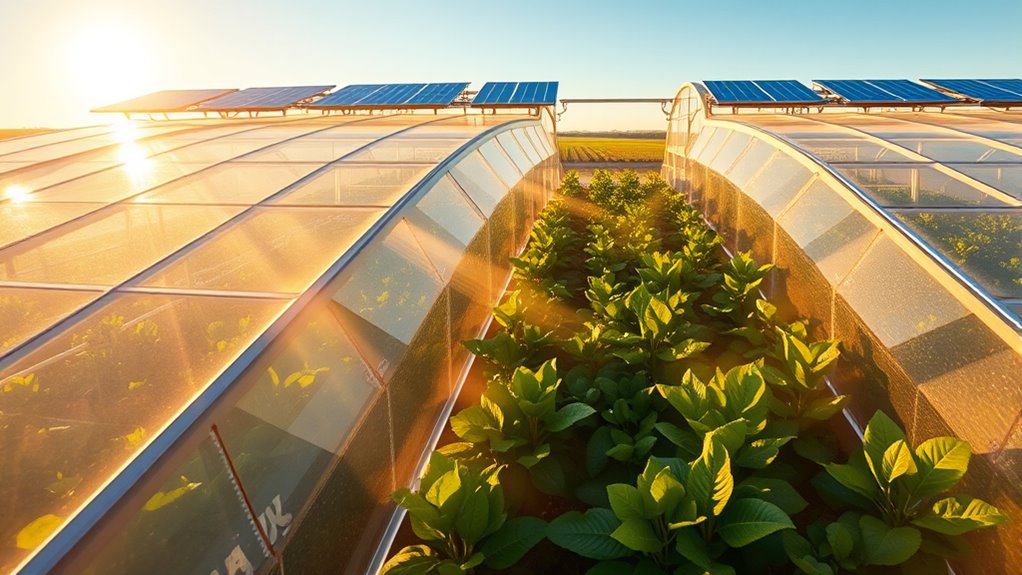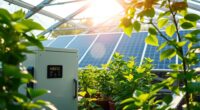Energy-efficient greenhouses harness solar power to help you grow crops year-round while cutting costs. By utilizing renewable energy, these greenhouses reduce carbon emissions and promote a healthier ecosystem. You’ll enjoy financial savings on energy bills, thanks to government incentives and advanced technologies that optimize growing conditions. With proper design elements and innovative features, these solar-powered structures can enhance your crop yields and minimize environmental impact. Discover how to maximize your gardening potential with these sustainable solutions.
Key Takeaways
- Solar-powered greenhouses reduce carbon emissions and promote healthier ecosystems while generating zero greenhouse gas emissions during operation.
- Utilizing advanced climate control systems, these greenhouses can maintain ideal temperature and humidity for optimal year-round crop production.
- Government incentives and tax credits can alleviate the upfront costs of solar panels, ensuring long-term financial savings on energy bills.
- Different designs, like passive and active solar greenhouses, maximize sunlight capture and energy efficiency for sustainable gardening practices.
- Innovations such as solar windows and transparent solar panels enhance energy generation while supporting healthier plant growth in controlled environments.
Environmental Benefits of Solar-Powered Greenhouses
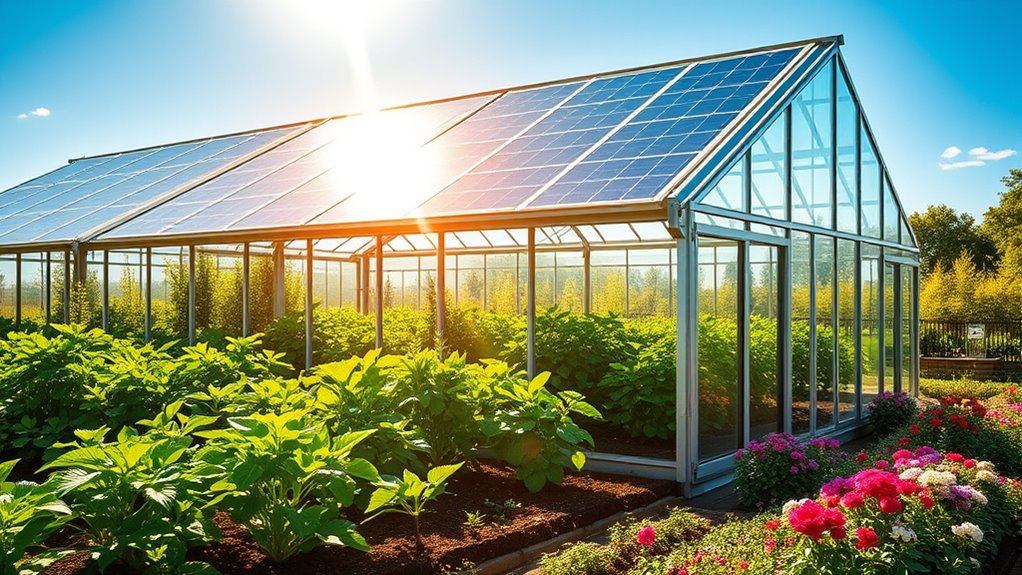
As you explore the environmental benefits of solar-powered greenhouses, you’ll find they play an essential role in reducing carbon emissions. By harnessing renewable energy, these greenhouses considerably lower your carbon footprint and generate zero greenhouse gas emissions during operation. This shift not only mitigates climate change but also decreases air and water pollution linked to fossil fuels. Additionally, solar energy conserves invaluable natural resources and promotes healthier ecosystems, supporting biodiversity. Furthermore, solar panels installed on these greenhouses provide a sustainable energy source that enhances their overall efficiency.
Moreover, incorporating energy-efficient equipment can further optimize resource usage and minimize waste, making your greenhouse even more sustainable. According to research, solar energy solutions increase crop yields and efficiency, allowing for more sustainable agricultural practices. By utilizing geothermal energy for heating, these greenhouses can maximize efficiency and further reduce their environmental impact.
Through energy-efficient practices, solar greenhouses minimize reliance on non-renewable sources while enhancing crop yields and extending growing seasons. By adopting these sustainable methods, you contribute to a cleaner environment and foster a resilient agricultural system that benefits both you and the planet.
Cost Savings and Financial Incentives
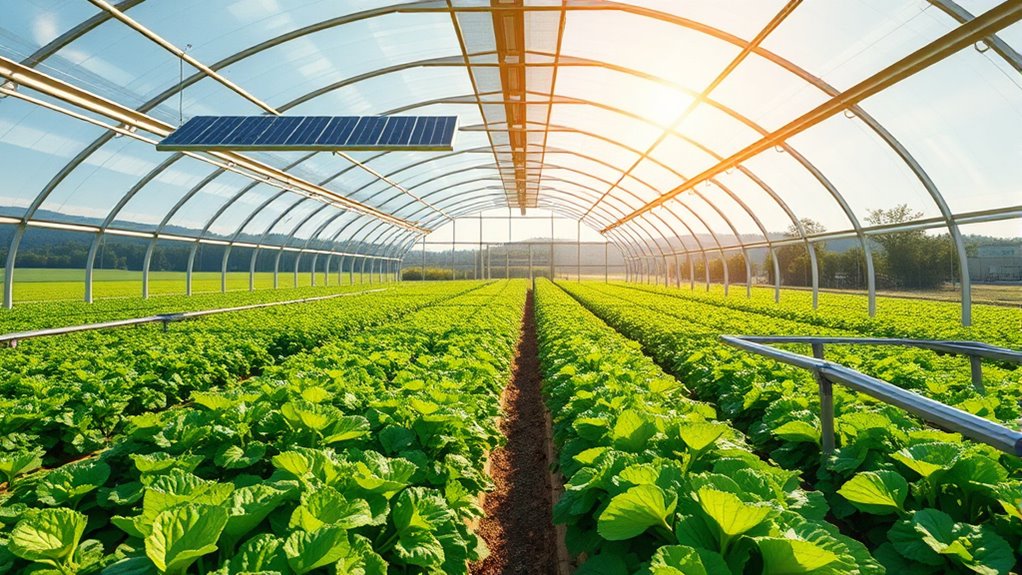
Solar-powered greenhouses not only contribute to a healthier environment but also offer considerable cost savings and financial incentives that make them an attractive option for growers.
By eliminating traditional heating and electricity costs, you can notably lower your energy bills. Although the initial investment in solar panels may seem high, the long-term savings often outweigh these costs. Additionally, proper greenhouse orientation maximizes light capture throughout the year, enhancing the efficiency of your solar setup. Creating comfortable living spaces for seniors through energy-efficient practices can also inspire sustainable gardening efforts. Implementing a battery-less solar inverter can further streamline your energy use, reducing the need for complex storage systems. Moreover, investing in energy-efficient practices can help mitigate the harmful effects of wood-burning emissions, contributing to a cleaner environment.
Government incentives, tax credits, and grants can further reduce your expenses. Plus, you can earn additional income through renewable energy credits and carbon offset programs.
With energy-efficient equipment and optimized resource use, you’ll not only enhance crop yields but also boost your profitability, giving you a competitive edge in the market.
Investing in solar greenhouses is a smart financial move.
Achieving Year-Round Crop Production
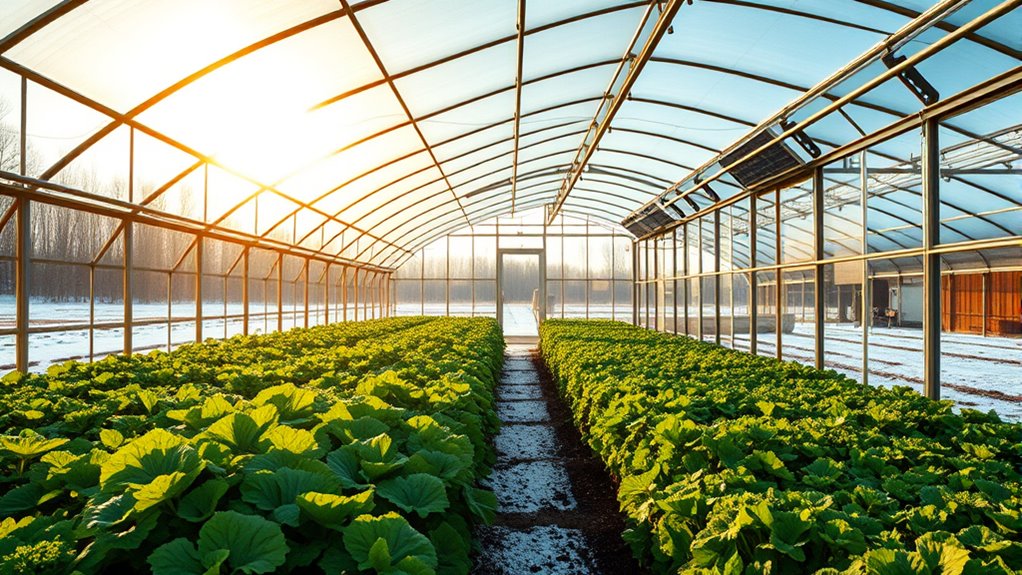
To achieve year-round crop production, growers can leverage advanced greenhouse technologies that create ideal growing conditions regardless of the season. By selecting crops like tomatoes, peppers, and root vegetables, you can guarantee a steady harvest throughout the year. Utilizing climate control systems allows you to regulate temperature and humidity effectively. Implementing a solar greenhouse design maximizes heat retention while minimizing energy costs. In colder climates, you can grow warm-weather crops like cucumbers and leafy greens year-round. properly managed greenhouses can lead to high yields throughout the year, and incorporating advanced greenhouse technologies can significantly improve your gardening success. Additionally, understanding the importance of energy-efficient designs can help you create a more sustainable growing environment. With automated systems for watering and fertilizing, you can optimize growth conditions. For instance, employing drainage features in your greenhouse setup can prevent waterlogging and promote healthy root systems. By integrating solar panels, you can further enhance sustainability, making your greenhouse not just productive but also energy-efficient. This combination leads to a thriving, year-round gardening experience.
Enhancing Crop Yields With Controlled Environments

By harnessing controlled environments, you can greatly enhance crop yields and create perfect conditions for plant growth.
With improved lighting, your crops benefit from ideal light conditions, boosting growth rates. Precise temperature management prevents stress and disease, while CO₂ enrichment enhances photosynthesis, promoting healthier plants. Additionally, automated climate control systems ensure that you can maintain consistent conditions, minimizing human error. Implementing organic farming methods can further improve soil health, providing a nutrient-rich environment for your crops. Engaging in hands-on learning experiences can also help you understand the intricacies of greenhouse management and crop cultivation.
Maintaining ideal humidity levels reduces disease risks, guaranteeing robust growth. Daisy varieties like Shasta and Gerbera can be grown successfully in controlled environments, offering beautiful blooms that attract pollinators. Automated systems help you maintain consistent conditions, minimizing human error.
Additionally, selecting crops suited to these environments maximizes efficiency and yield. Vertical farming allows for increased planting density, enhancing output per area. Tailoring conditions to specific growth stages ensures plants develop effectively. Embracing these strategies means you’ll enjoy a bountiful harvest year-round, maximizing your greenhouse’s potential.
Key Design Elements for Solar Greenhouses

When designing a solar greenhouse, focusing on key elements can considerably enhance its efficiency and functionality.
First, orient your greenhouse to face south for maximum sunlight capture, maximizing passive solar heating. Use high-quality polycarbonate or glass glazing for ideal light transmission while considering potential overheating. Additionally, integrating wood-burning stoves can provide a sustainable heating source during colder months. Understanding the importance of long-term financial planning for energy-efficient improvements can further enhance the investment in your greenhouse. Incorporating heat pumps can also significantly increase the energy efficiency of your greenhouse environment.
Incorporate effective insulation materials like polystyrene or eco-friendly natural fibers to reduce heat loss. Add thermal mass elements, such as water or stone, to absorb heat during the day and release it at night, stabilizing temperatures. This design allows for energy-efficient greenhouses that significantly cut operational costs.
Guarantee proper ventilation with solar-powered fans and automated vents to maintain ideal conditions.
Finally, consider sustainable construction practices and solar panels to power systems, promoting energy efficiency and reducing long-term costs.
Different Types of Solar Greenhouses
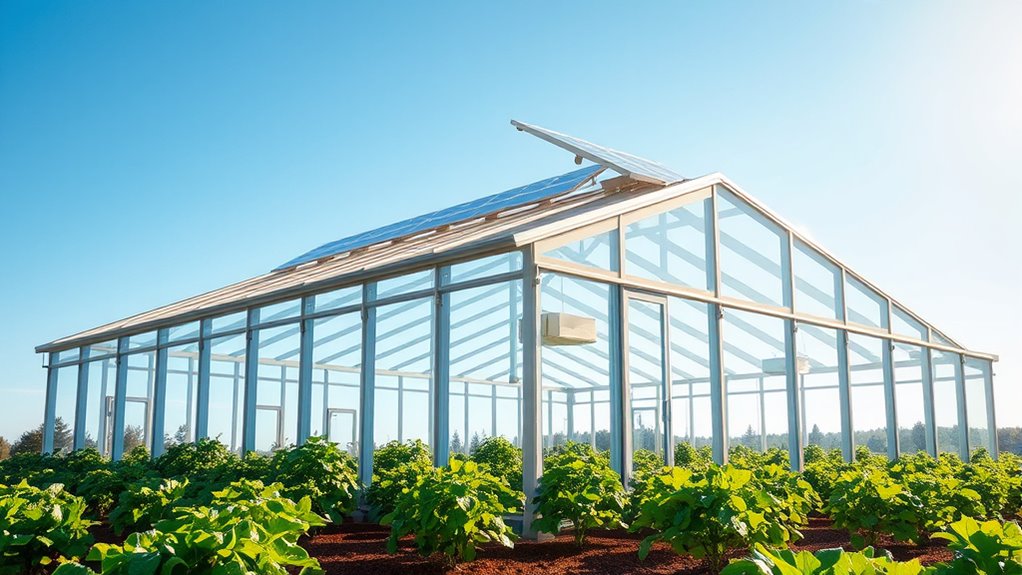
Designing an energy-efficient greenhouse involves more than just key elements; it also encompasses the various types of solar greenhouses available today. Passive solar greenhouses utilize natural materials to capture and retain heat, while active solar greenhouses integrate photovoltaic panels for powering systems. If you’re looking for unique designs, consider Chinese solar greenhouses, which feature solid walls and a transparent south-facing side, or Yin-Yang greenhouses, which blend sunlight capture with insulation. Geodesic dome greenhouses stand out for their efficient heat distribution. Multi-Span Greenhouses can also be designed to harness solar energy effectively, providing ample space for diverse crop cultivation. Each type offers distinct benefits, ensuring you can choose a design that fits your gardening needs and climate. Embrace these options to optimize your gardening experience year-round, while also considering innovations in geothermal heat pumps that can enhance energy efficiency in your greenhouse. Additionally, these greenhouses can play a significant role in promoting sustainable technologies by reducing energy consumption and supporting eco-friendly practices. Understanding risk management strategies can further ensure the long-term viability of your gardening investments.
Overcoming Challenges and Limitations

While energy-efficient greenhouses offer numerous benefits, they also present challenges and limitations that you’ll need to navigate.
One major hurdle is the high upfront costs of solar panels and equipment. Conducting a thorough cost-benefit analysis can help you see if long-term savings justify these initial expenses. Financial incentives from governments can also ease this burden. Additionally, energy assessment can help identify measures that will yield the best savings, potentially offsetting some initial costs. Implementing smart technology integration can further optimize energy use and enhance overall efficiency. Understanding common fees associated with solar equipment can also aid in budgeting for your greenhouse project.
Additionally, you’ll face technical challenges requiring specialized knowledge, so training and support are essential. Regular maintenance is vital for peak performance, and implementing monitoring systems can help catch issues early.
Finally, design restrictions, like optimizing orientation for solar capture, may limit your flexibility, but innovative materials and customized solutions can enhance efficiency without compromising design.
Innovations in Solar Greenhouse Technology
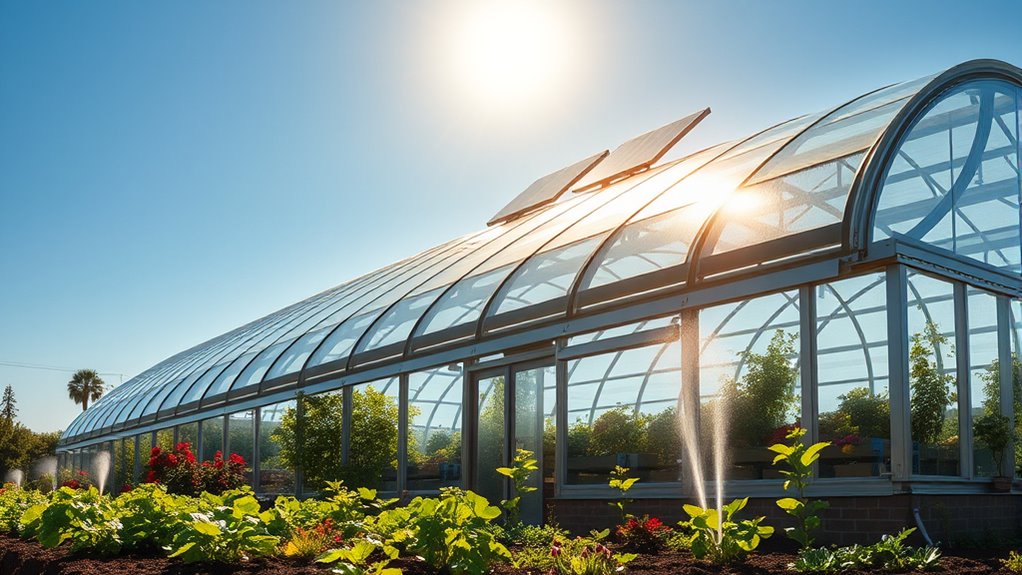
As solar greenhouse technology evolves, innovative solutions are transforming how you approach sustainable agriculture.
For instance, solar windows developed by Australian researchers let in 70% of sunlight while generating electricity, cutting energy needs by 57% and reducing water use by 29%. These windows also make greenhouses self-sufficient in energy, demonstrating a significant leap in agricultural technology.
You can also benefit from passive solar designs that maintain stable temperatures using thermal masses.
With transparent and magenta solar panels, you’ll enhance plant growth while generating energy.
These advancements enable year-round gardening and reduce operational costs.
By integrating solar panels, you power irrigation and climate control systems, ensuring energy efficiency.
The Future of Sustainable Agriculture and Energy Efficiency
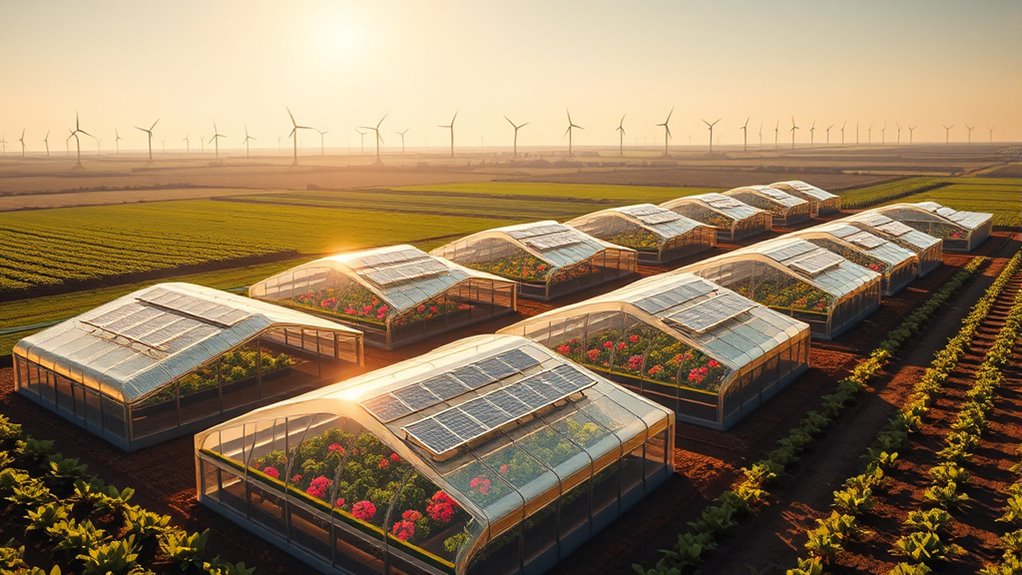
The future of sustainable agriculture and energy efficiency hinges on integrating innovative technologies and practices that reduce environmental impacts while boosting productivity.
By adopting renewable energy sources like solar and wind, you can markedly cut greenhouse gas emissions and lower energy costs. Programs like REAP support your efforts to implement energy-efficient equipment, enhancing both sustainability and profitability. Solar-powered greenhouses utilize renewable energy to maintain optimal growing conditions throughout the year, ensuring that your gardening efforts are not only productive but also environmentally friendly.
Precision agriculture and agroforestry techniques will further optimize resource use, ensuring efficient water and energy consumption. Embracing a circular economy approach will help you manage waste and promote sustainability in food systems.
As technology advances and policies evolve, the economic viability of these solutions will improve, making it easier for you to contribute to a greener, more sustainable agricultural future.
Frequently Asked Questions
What Maintenance Is Required for Solar-Powered Greenhouses?
Maintaining solar-powered greenhouses involves a few essential tasks. You need to regularly clean the solar panels to guarantee efficiency and check their tilt and orientation for maximum sunlight capture.
Inspect the entire system for any damage or loose connections. Additionally, monitor the structural integrity of the greenhouse and maintain drainage systems to prevent water buildup.
Automate environmental controls and keep insulation intact for peak energy use and sustainable operation.
How Do I Choose the Right Location for My Greenhouse?
When choosing the right location for your greenhouse, you’ll want to prioritize sunlight exposure, aiming for at least six hours of direct sun daily.
A south-facing orientation is ideal if you’re in the Northern Hemisphere.
Assess the topography for flat or gently sloping land and guarantee good drainage.
Avoid shady spots from structures or trees, and consider wind protection.
Finally, make certain there’s easy access for maintenance and sufficient water supply.
Can Solar Greenhouses Host Multiple Types of Crops?
Yes, solar greenhouses can host multiple types of crops.
Picture a checkerboard pattern where leafy greens thrive in shaded areas while taller plants bask in sunlight. By adjusting light conditions, you can cultivate crops like lettuce and herbs, which flourish in partial shade.
This setup creates a unique microclimate, enhancing growth and yield. So, you’ve got the flexibility to grow various crops year-round, maximizing both productivity and sustainability.
What Are the Best Practices for Winterizing Solar Greenhouses?
To winterize your solar greenhouse effectively, start by enhancing insulation with double-glazed glass and thermal curtains.
Increase soil depth and cover it with straw mats at night to retain heat.
Adjust vents for ideal airflow, and use circulation fans to distribute warmth evenly.
Clean and inspect the structure for gaps, and install efficient heating systems.
Finally, regularly manage shade cloth to maximize sunlight during the day and retain heat at night.
How Do Solar Greenhouses Impact Local Wildlife and Ecosystems?
Solar greenhouses can dramatically reshape local ecosystems, like a giant puzzle piece disrupting the natural landscape. They alter habitats and fragment wildlife movement, affecting species’ survival.
Additionally, the noise and light pollution from these structures can interfere with animal behaviors. However, with careful site selection and innovative designs, you can mitigate these impacts.
Conclusion
Incorporating solar power into your greenhouse can revolutionize your gardening experience while promoting sustainability. Imagine growing fresh tomatoes and herbs year-round, even in winter, by harnessing the sun’s energy. Not only will you enjoy a bountiful harvest, but you’ll also save on energy costs, just like a farmer in California who reported a 30% reduction in heating expenses after switching to a solar-powered greenhouse. Embrace this innovative approach and watch your gardening dreams flourish all year long!
